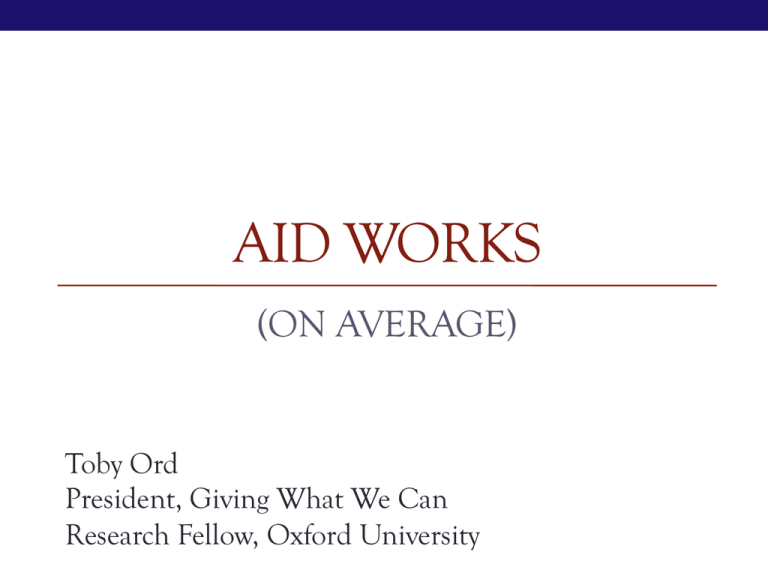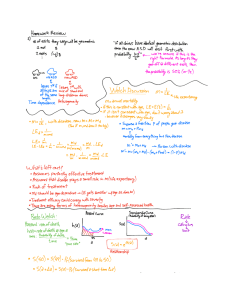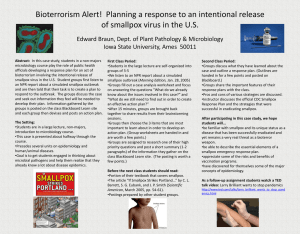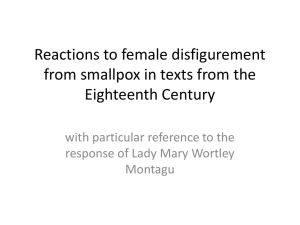AID WORKS (ON AVERAGE) Toby Ord President, Giving What We Can
advertisement

AID WORKS (ON AVERAGE) Toby Ord President, Giving What We Can Research Fellow, Oxford University INTRODUCTION Moyo • ‘So there we have it: sixty years, over US$1 trillion dollars of African aid, and not much good to show for it.’ • ‘Since the 1940s, approximately US$1 trillion of aid has been transferred from rich countries to Africa. This is nearly $1,000 for every man, woman and child on the planet today.’ Moyo • $1 trillion / 7 billion (world pop) = $142 per person = $2.38 per year per person • $1 trillion / 440 million (average pop of SSA through period) = $2,263 per recipient = $38 per year per recipient • ‘not much good to show for it.’ • Life expectancy in 1950 = 37.1 years • Life expectancy in 2010 = 55.0 years • Gain = 17.9 years = 48% Easterly • $2.3 trillion in aid • but ‘so little good’ • c.f. Rumsfeld’s 10 Sep 2001 speech • US military has lost track of $2.3 trillion Easterly • One chapter devoted to health aid • Reports strong evidence that it works • Spends 2 pages on admitted successes, then 24 pages on AIDS • ‘Although the aid agencies have not calculated the aid impact in a scientifically rigorous way, the broad facts support the belief that aid was effective in many of the above health interventions. Alas, instead of expanding success in the many health areas where it had triumphed, the international health community was going to get bogged down in its equivalent of Vietnam: AIDS.’ Riddell • Looks at whether things ‘work’ across many sectors. • Mentions smallpox eradication and river blindness control as examples of clear successes (with figures) • But doesn’t dwell on just how successful they were • e.g. smallpox eradication did 200x more, with less money SEEKING CLARITY ‘Does Aid Work?’ • Does aid produce economic growth? • Do different aid sectors work? • Does some aid have negative effects? • Does the typical aid dollar work? • What proportion of aid works? What do we know already? • Evidence of the effects of aid on economic growth is weak • It might have no effect • It might have a positive effect • It might have a negative effect • Some aid achieves nothing • Some aid makes things worse • Some aid makes things better • Especially clear in global health My Central Question Does the average aid dollar do enough to make aid a good deal overall? Measured Cost-Effectiveness of Health Measured Cost-Effectiveness of Health worth the cost Measured Cost-Effectiveness of Health worth the cost The Aid Effectiveness Landscape The Aid Effectiveness Landscape most beneficial most harmful The Aid Effectiveness Landscape total benefit total harm The Aid Effectiveness Landscape proportion that is beneficial The Aid Effectiveness Landscape worth the cost proportion that is beneficial proportion that is worth the cost The Aid Effectiveness Landscape average effect worth the cost average net gains from aid The Aid Effectiveness Landscape The Aid Effectiveness Landscape The Aid Effectiveness Landscape SMALLPOX Smallpox • Scourge of humanity for thousands of years • Distinctive rash • Highly infectious • Kills 1 in 3 infected people (in about 10 days) • Kills 80% of infected children • Blinds 10% of survivors • In China and India people invented smallpox gods War Smallpox War Smallpox War 160 – 240 million Smallpox War Smallpox 160 – 240 million 300 – 500 million c. 1000 — Inoculation 1796 — Vaccination 1959 — World Health Assembly Resolution The Jet Injector Bifurcated Needle Freeze Dried Vaccine 1967 — Intensified Eradication Programme 1968 — Surveillance and Containment 1977 — Last Natural Case 1978 — Last Death 1979 — Certified Eradication The Most Crucial Components • The World Health Organization • Was a focal point for passing resolutions and uniting the world’s will • United world medical and scientific expertise • Coordinated a world programme, which distributed vaccine and skills • Heat stable vaccine • The Surveillance and Containment Strategy • Financing Finances Costs (1967 – 1979) Current $ International $0.5 billion Endemic Countries $1.0 billion Total $1.5 billion Savings (annual) Current $ US $1.0 billion Endemic Countries $7.4 billion War 20th C 160 – 240 million Smallpox 300 – 500 million War 20th C 160 – 240 million Per Year average: 1.6–2.4 million Smallpox 300 – 500 million average: 3–5 million early: >5 million 1950: 3 million 1967: 1.5–2 million War 20th C 160 – 240 million Per Year average: 1.6–2.4 million Lives Saved Smallpox 300 – 500 million average: 3–5 million early: >5 million 1950: 3 million 1967: 1.5–2 million 60 – 120 million Cost-Effectiveness Cost-Effectiveness • $1.5 billion / 60 million lives saved = $25 per life saved • Total aid spending so far • Moyo says $1 trillion to Africa • Easterly says $2.3 trillion total • I’ll conservatively update this to $4 trillion total • $4 trillion / 60 million lives saved = $67,000 per life saved = one percent of what the US govt. will spend to save a life = about what the NHS will spend to save two years of life • Enough to make aid effective on average • Even if we only count a third (or a tenth!) of the lives saved as due to aid OTHER BIG WINS Malaria, Diarrheal Disease, & Immunization Other Immunization • Measles is estimated to have killed 200 million over last 150 years • Measles mortality is 0.1% in rich countries, 10% in poor ones • Measles is now on its way to eradication • Annual deaths from immunization preventable illnesses cut from 5 million in 1960 to 1.4 million in 2001 Malaria • Mosquito borne blood parasite • Causes fever and occasional death • Nets, indoor spraying, medicine • 2011 international funding: $1.84 billion • 2011 local funding: $0.63 billion • Annual malaria deaths cut from 3.8 million to about 0.7 million • Potentially eradicable Diarrhoeal Illness • Cholera and other illnesses • IV therapy introduced in 1831 • Cut mortality from 70% to 40% • Oral Rehydration Therapy in 1968 • Rose to prominence during the Bangladesh Liberation War • Cut mortality from 30% to 3.6% • And was simpler and cheaper • Incredibly cheap and simple • Cut annual diarrhoeal deaths from 4.6 million to 1.6 million Deaths per year Summary 1960 2001 1980 2001 1930 2010 1950 1979 average Immunizable Diarrhoeal Malaria Smallpox War What have the Romans ever done for us? • ‘not much good to show for it’ — Moyo • ‘so little good’ — Easterly What have the Romans ever done for us? • ‘not much good to show for it’ — Moyo • ‘so little good’ — Easterly • ‘All right, all right… but apart from better sanitation and medicine and education and irrigation and public health and roads and a freshwater system and baths and public order... what have the Romans done for us?’ — Monty Python CONCLUSIONS Conclusions • Aid is complicated • Some aid works, some doesn’t • The best aid has been astoundingly good • It has been one of the best things in world history • It has saved more lives than world peace would • It has been enough to make aid work on average even if all other aid was worthless • We need to pay great attention to cost-effectiveness in aid • We should be quantitative and look for the really big wins




